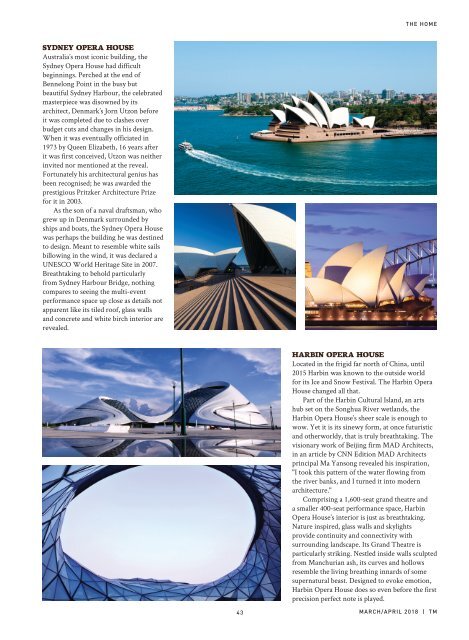Tropicana Magazine Mar-Apr 2018 #117: Edge Of Excitement
MARCH into April with the Edge of Excitement: Featuring the power couple of sustainability, legendary dancer Datuk Ramli Ibrahim, and the swanky bars of Singapore. Read it here now:
MARCH into April with the Edge of Excitement: Featuring the power couple of sustainability, legendary dancer Datuk Ramli Ibrahim, and the swanky bars of Singapore. Read it here now:
You also want an ePaper? Increase the reach of your titles
YUMPU automatically turns print PDFs into web optimized ePapers that Google loves.
THE HOME<br />
SYDNEY OPERA HOUSE<br />
Australia’s most iconic building, the<br />
Sydney Opera House had difficult<br />
beginnings. Perched at the end of<br />
Bennelong Point in the busy but<br />
beautiful Sydney Harbour, the celebrated<br />
masterpiece was disowned by its<br />
architect, Denmark’s Jorn Utzon before<br />
it was completed due to clashes over<br />
budget cuts and changes in his design.<br />
When it was eventually officiated in<br />
1973 by Queen Elizabeth, 16 years after<br />
it was first conceived, Utzon was neither<br />
invited nor mentioned at the reveal.<br />
Fortunately his architectural genius has<br />
been recognised; he was awarded the<br />
prestigious Pritzker Architecture Prize<br />
for it in 2003.<br />
As the son of a naval draftsman, who<br />
grew up in Denmark surrounded by<br />
ships and boats, the Sydney Opera House<br />
was perhaps the building he was destined<br />
to design. Meant to resemble white sails<br />
billowing in the wind, it was declared a<br />
UNESCO World Heritage Site in 2007.<br />
Breathtaking to behold particularly<br />
from Sydney Harbour Bridge, nothing<br />
compares to seeing the multi-event<br />
performance space up close as details not<br />
apparent like its tiled roof, glass walls<br />
and concrete and white birch interior are<br />
revealed.<br />
HARBIN OPERA HOUSE<br />
Located in the frigid far north of China, until<br />
2015 Harbin was known to the outside world<br />
for its Ice and Snow Festival. The Harbin Opera<br />
House changed all that.<br />
Part of the Harbin Cultural Island, an arts<br />
hub set on the Songhua River wetlands, the<br />
Harbin Opera House’s sheer scale is enough to<br />
wow. Yet it is its sinewy form, at once futuristic<br />
and otherworldy, that is truly breathtaking. The<br />
visionary work of Beijing firm MAD Architects,<br />
in an article by CNN Edition MAD Architects<br />
principal Ma Yansong revealed his inspiration,<br />
"I took this pattern of the water flowing from<br />
the river banks, and I turned it into modern<br />
architecture."<br />
Comprising a 1,600-seat grand theatre and<br />
a smaller 400-seat performance space, Harbin<br />
Opera House’s interior is just as breathtaking.<br />
Nature inspired, glass walls and skylights<br />
provide continuity and connectivity with<br />
surrounding landscape. Its Grand Theatre is<br />
particularly striking. Nestled inside walls sculpted<br />
from Manchurian ash, its curves and hollows<br />
resemble the living breathing innards of some<br />
supernatural beast. Designed to evoke emotion,<br />
Harbin Opera House does so even before the first<br />
precision perfect note is played.<br />
43 MARCH/APRIL <strong>2018</strong> | TM


















